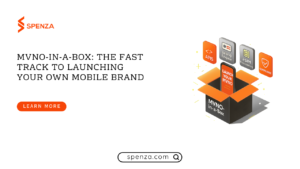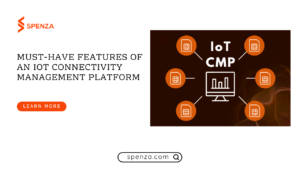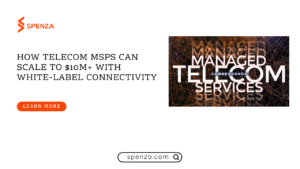Business connectivity is no longer defined by plastic SIM cards or manual provisioning. The global shift from traditional SIM technology to embedded SIM (eSIM) represents more than just a hardware upgrade—it marks a major transformation in how companies deliver mobile services, manage devices, and scale operations.
Across industries—from IoT device manufacturers to direct-to-consumer electronics brands and global enterprises—eSIM is redefining what’s possible. It eliminates long-standing barriers such as physical SIM logistics, carrier lock-in, and activation delays, replacing them with software-driven agility.
Historically, telecom has been off-limits for technologists due to high capital expenditures, a complex ecosystem, stringent regulations, and entrenched incumbents with walled-garden models. The good news? This is rapidly changing, thanks to growing eSIM adoption by users and businesses alike.
As a technologist, you no longer need to rely on telecom operators for every deployment. There’s no need to manage SIM inventory or customize devices by region. And you don’t have to overhaul your product line to capitalize on this shift. With the right strategy and tools, you can embed global, programmable connectivity into your offering—seamlessly and securely.

Now is the right time to act. The eSIM market is scaling fast. By 2032, it is projected to reach $20.6 billion, underlining its growing role as a foundation for global connectivity. That figure isn’t just impressive, it’s a clear signal that businesses adopting eSIM early will gain real strategic advantages.
This guide gives you the full context. We break down what eSIM really is, how it works, and what your business can do right now to build services, products, and revenue models around it.
Here’s what you’ll learn:
- What is eSIM: A practical explanation
- eSIM vs SIM vs iSIM: Understand the options
- Benefits for modern businesses
- Real-world use cases
- Key steps to launching your eSIM offering
- How to choose the right platform partner
- Future trends: What comes next
What Is eSIM? A Practical Explanation
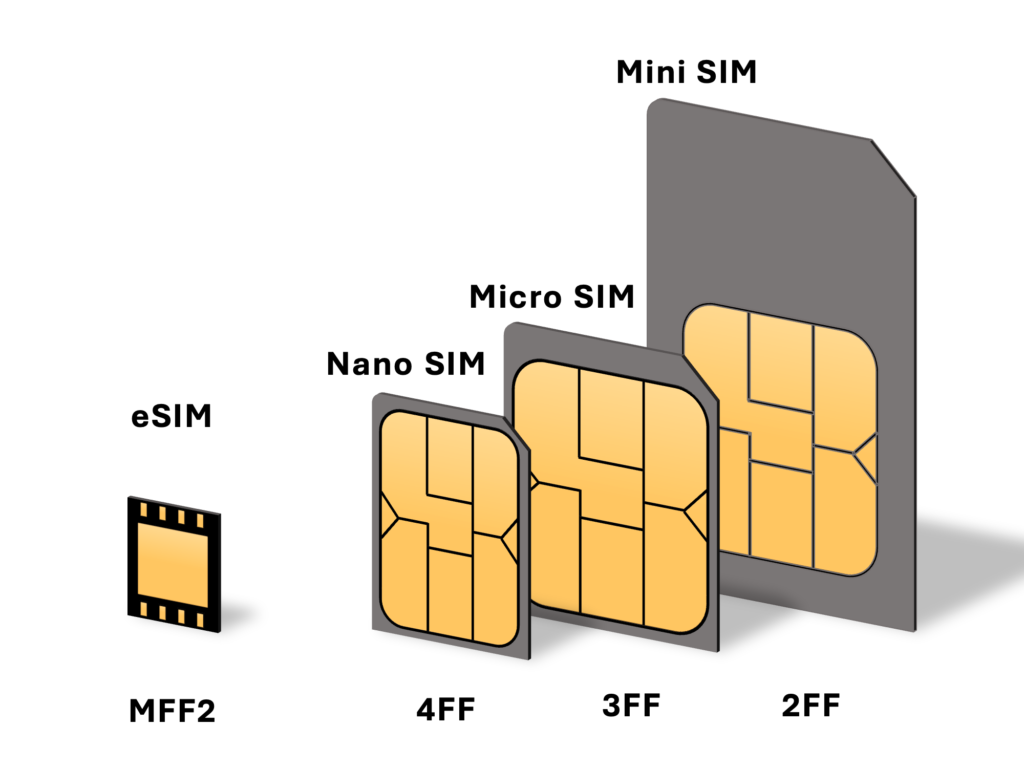
eSIM stands for “Embedded SIM.” Unlike traditional SIM cards that require manual insertion, an eSIM is built directly into the device as a programmable chip. It enables mobile connectivity without any physical handling, plans can be activated, updated, or switched remotely, using software alone.
This removes the need for physical SIM logistics, no trays to open, no cards to ship, and no region-specific configurations. Devices connect to the same cellular networks, but the setup is entirely digital and far more efficient.
eSIM technology now powers a wide range of connected products, from smartphones and tablets to IoT sensors, smartwatches, industrial equipment, and connected vehicles. Leading manufacturers like Apple, Samsung, and Google already ship eSIM-enabled devices as standard.
In 2025, eSIM is no longer optional. The transition is well underway. Apple’s latest models have already eliminated the SIM tray in key markets, signaling a permanent move toward software-based connectivity at scale.
Want to learn more? Check this: Plastic SIM is Dead, Long Live the eSIM
eSIM vs Traditional SIM vs iSIM: What’s Different?
Businesses exploring connected solutions often face a key decision: choosing between traditional SIM, eSIM, or iSIM. Each option serves the same purpose, network connectivity, but differs in how it’s integrated and managed.
Understanding these differences helps you select the right solution for your product, market, and growth strategy.
Here’s a simple breakdown:
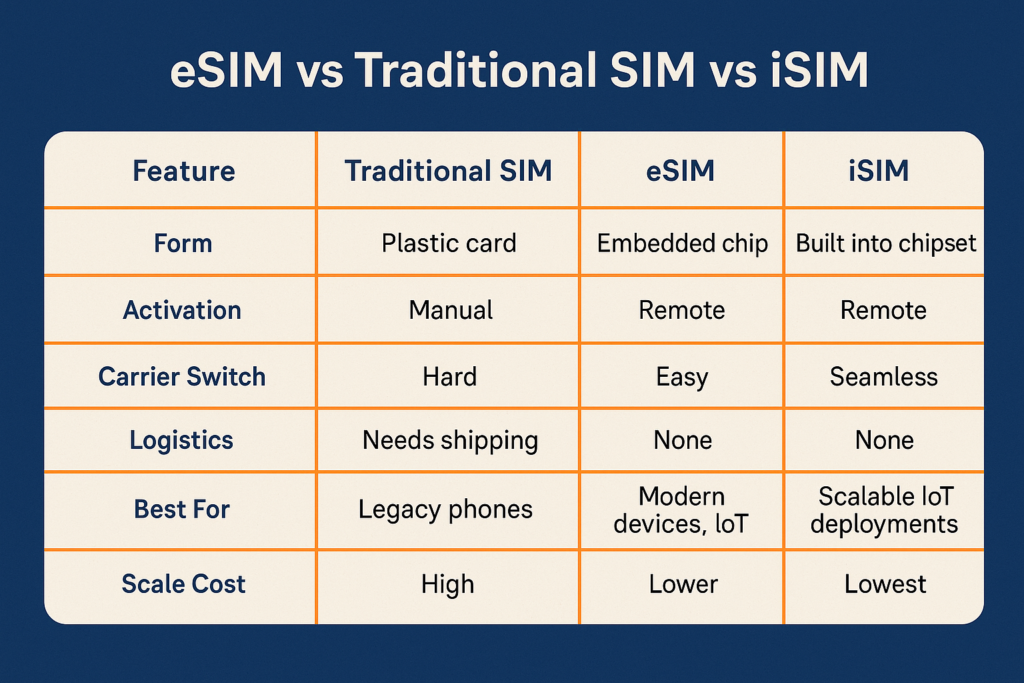
For an in-depth comparison, read:
- eSIM vs Traditional SIMs: Which is Right for Your Business?
- iSIM vs eSIM: Next-Gen Cellular IoT Connectivity Explained
Why Businesses Are Switching to eSIM in 2025
There’s no mystery here. Businesses are switching because eSIM fixes long-standing problems.
Let’s break it down:
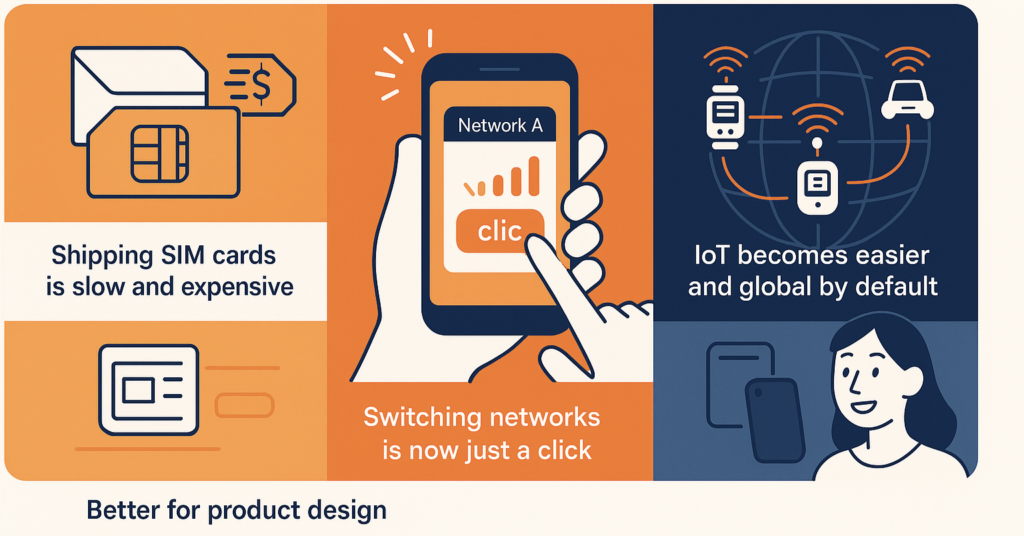
1. Shipping SIM cards is slow and expensive
Every device shipped with a SIM tray creates waste. Delays. Mistakes. Lost cards. eSIM removes all that. You activate service before the box is even opened.
2. Switching networks is now just a click
You’re not locked to one provider. You can change plans over-the-air. You stay flexible. You pick the plan that fits. No contracts tying you down.
3. IoT becomes easier and global by default
You don’t have to stock local SIMs in 20 countries. You provision one eSIM, update remotely, and move on.
See this real-world use: Transform Global IoT Management with Remote eSIM Provisioning
4. Better for product design and customer experience
You can finally get rid of SIM trays. No pins. No fiddling. Just a cleaner device and a better out-of-box experience.
Want a full view? Check this: Unleash the Potential of eSIM to Transform Connectivity Across Industries
Who Should Use eSIM in 2025?
eSIM is not built only for mobile carriers. Its benefits apply far beyond telecom. In 2025, businesses across multiple sectors use eSIM to simplify device connectivity, reduce costs, and improve the end-user experience. If your company ships connected products or manages devices in the field, this technology is no longer optional, it is essential.
Here’s how different business types are adopting eSIM today:
1. IoT Product Manufacturers
For companies building asset trackers, sensors, industrial meters, or smart wearables, eSIM is the logical choice. It eliminates the need for stocking different SIM cards by region. You can provision connectivity remotely and streamline global shipping. Devices arrive ready to use, no extra configuration needed. This improves deployment speed and reduces support issues.
Learn more: Introduction to eSIM in IoT connectivity
2. Consumer Device Brands (D2C)
Brands selling connected fitness devices, kids’ phones, or smartwatches can embed eSIM to deliver a complete solution out of the box. Customers activate connectivity without going through third-party carriers. This improves brand loyalty and gives you access to recurring revenue streams from data plans.
Explore how it works: Monetizing Brand Loyalty with Spenza Mobile eSIM Plans
3. Telematics and Fleet Providers
Companies managing fleets—whether delivery vans, trucks, or rental vehicles, need reliable, centralized control over connectivity. With eSIM, you can roll out uniform plans across all regions without swapping SIMs or coordinating with multiple operators. Updates and changes happen remotely, which saves time and lowers field maintenance costs.
4. Travel and Hospitality Brands
If your business serves international travelers, eSIM lets you offer local data plans that work instantly. There’s no physical SIM to manage, which removes friction during onboarding. Tourists simply scan a QR code and connect. This is especially popular with younger, digital-first travelers who expect fast and seamless solutions.
See how it supports travel: Why Young Travelers Are Embracing eSIM
5. Enterprises with Remote Teams or BYOD Environments
For companies supporting bring-your-own-device policies or managing distributed workforces, eSIM allows you to provision mobile plans directly to employee phones—without touching the devices. You reduce manual setup, secure corporate data, and maintain full control over usage and billing from a central platform.
See full use case: eSIM for Enterprise – Why eSIM and BYOD are made for each other
Building a Branded eSIM Marketplace
Forward-thinking brands are not just using eSIM, they are launching their own eSIM services. With the right platform, you can build a fully branded eSIM store without running your own network.
This allows you to:
- Sell data plans directly to customers
- Enable self-service activation through your website or app
- Offer localized plans for global markets
- Control pricing, user experience, and service tiers
- Build recurring revenue on top of your existing product business
You don’t need to build infrastructure or negotiate with dozens of carriers. A turnkey eSIM platform like Spenza handles the heavy lifting. You stay focused on your brand, your product, and your customers.
Want a real example? Read: Launching Your Branded eSIM Marketplace in 2025
How to Launch Your Own eSIM Offer
Launching eSIM in 2025 is no longer a complex or costly process. With the right structure and tools, businesses of any size can offer their own eSIM service. If you are enabling global connectivity for IoT devices or creating a branded travel SIM experience, the process follows a clear path. The key is to stay focused, build in stages, and rely on a trusted platform
Follow these five essential steps:
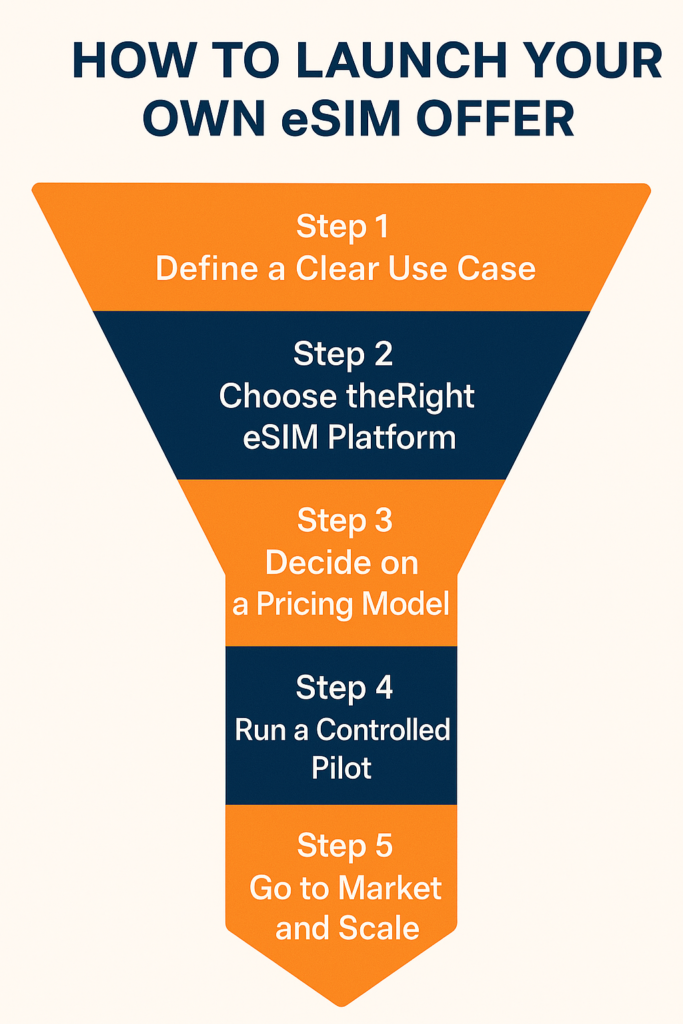
Step 1: Define a Clear Use Case
Start with one product or audience. Are you enabling connectivity for wearable devices? Are you supporting fleet vehicles across state lines? Or are you planning to sell prepaid travel data for international customers? Focused execution will help you validate the model faster and manage costs more effectively.
Step 2: Choose the Right eSIM Platform
Avoid building your infrastructure from scratch. An eSIM management platform gives you access to remote provisioning, billing, SIM profile downloads, carrier switching, and customer controls. A provider like Spenza already brings these elements together, so you can launch without long negotiations or custom development.
Step 3: Decide on a Pricing Model
Your pricing structure needs to align with your business goals. Will you charge monthly? Will you offer pay-as-you-go plans? Do you want to bundle connectivity with your hardware? Subscription models work well for ongoing usage, while usage-based plans fit short-term or seasonal needs.
Need help making a decision? Explore this: Pricing Models of IoT eSIM Providers
Step 4: Run a Controlled Pilot
Before launching widely, test with a limited release. Provision a small batch of devices. Activate real customer profiles. Monitor billing accuracy and customer onboarding. Ensure the QR-code setup, plan selection, and support workflows function as expected. Use this stage to fix gaps, simplify the user journey, and finalize your internal process.
Step 5: Go to Market and Scale
Once the system works as expected, move into full launch. Add your eSIM setup process directly into the product box or app experience. Offer self-service activation. Use email campaigns or retail support to drive adoption. As you grow, expand into new markets and introduce plan options for different regions or use cases.
Why Spenza Is the Smarter Way to Launch
Spenza helps companies launch eSIM services without starting from zero. You do not need direct carrier relationships. You do not need to invest in a custom billing engine. And you do not need to wait months to enter the market.
With Spenza, your team gets:
- A fully integrated eSIM backend
- Global connectivity through pre-established carrier partnerships
- Secure remote provisioning tools
- Branded plan creation and management
- Centralized customer controls
- Scalable billing options for any business model
Whether you are offering one product or supporting thousands of devices, Spenza handles the operational complexity so you can focus on growth and customer success.
Want to see how this works in real-world campaigns? Explore: Reinventing Loyalty Programs with eSIM Data Plans
What’s Coming Next: eSIM Trends to Watch in 2025
This year, eSIM is entering a new phase. Hardware, standards, and user expectations are shifting quickly. Companies that act early will move ahead while others are still adapting. Below are four trends shaping the market:
eSIM-Only Devices Are Becoming Standard
Apple has already eliminated SIM trays in several markets. More manufacturers are following this model. Businesses must prepare now to support digital-only activation flows, especially for users expecting fast and seamless onboarding.
SGP.32 Brings Simplicity to More Devices
The new SGP.32 standard improves eSIM profile management across operating systems and hardware types. It removes many of the technical barriers that previously slowed adoption, especially for smaller OEMs or non-smartphone use cases.
Learn how it works: SGP.32 Explained
IoT Growth Makes eSIM a Core Requirement
As more IoT devices hit the market, global connectivity becomes a must. eSIM helps companies ship one product and activate anywhere without supply chain delays. Sensors, trackers, and industrial hardware all benefit.
Explore this shift: How eSIM Technology is Transforming Global IoT Connectivity
Brands Will Use eSIM to Power Loyalty and Rewards
Some brands now tie eSIM data plans to loyalty programs or in-app rewards. This helps drive repeat purchases, improves user retention, and gives non-telco companies a new channel for growth.
See this in action: Reinventing Loyalty Programs with eSIM Data Plans
Final Word: The Shift Has Already Started
This is not a future prediction. The shift to eSIM is already here. Major players have moved. Device makers, software companies, and logistics firms are embedding this model into their core operations.
If you manage connected devices, support remote teams, or want a recurring revenue model tied to mobile access, eSIM is not optional anymore.
You do not need to rebuild your stack or chase telecom deals. You only need to start. The earlier you move, the stronger your position in the market.
FAQs
eSIM eliminates SIM logistics, enables global scalability, and allows instant remote activation, making it essential for modern businesses managing connected devices and remote teams.
eSIM uses encrypted remote SIM provisioning protocols and tamper-resistant hardware, making digital SIM management more secure than traditional SIM cards in most enterprise deployments.
If a device is lost or damaged, eSIM profiles can be remotely deactivated and transferred to a new device, simplifying recovery through centralized digital SIM management.
Yes. eSIM profiles can be remotely wiped, allowing SIM-less devices to be securely reused, resold, or recycled without the risks tied to physical SIM cards.
Yes. With platforms like Spenza, companies can launch branded eSIM services without carrier deals, offering global data plans, customer control, and recurring revenue streams.
While traditional models required high capital expenditure, modern MVNE platforms allow for a much more accessible, operational expenditure-based model. The exact cost depends on your specific model and goals, but you can get a detailed estimate using our free MVNO Cost Calculator
Contact us to schedule a demo and learn how Spenza can transform your connectivity strategy.


